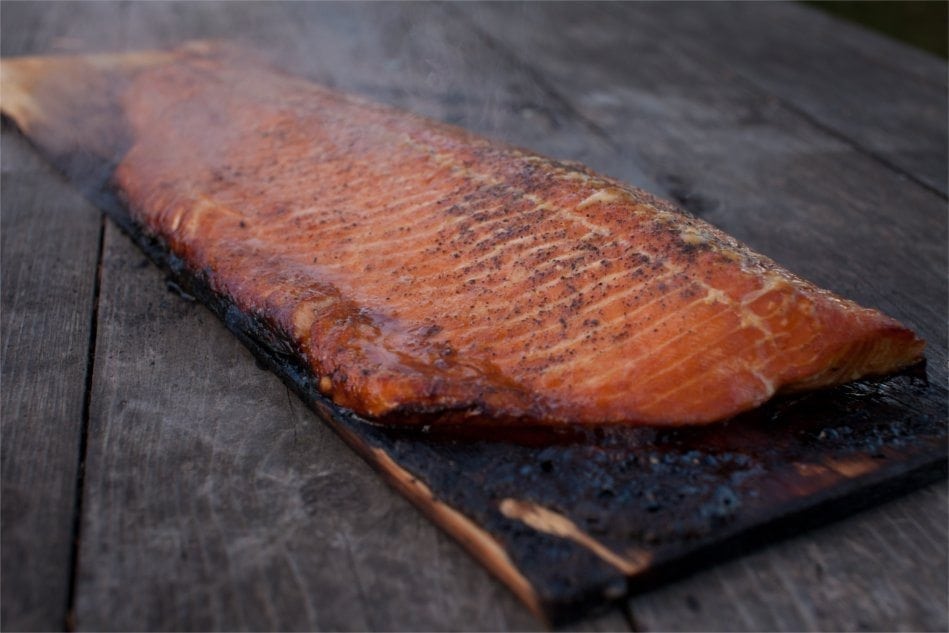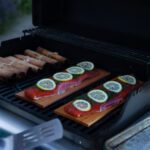When you want to buy wild-caught salmon, it’s hard to know what to look for. But who better to tell us the questions to ask than an Alaskan fisherwoman herself?
Gratitude Beyond the BBQ & How to Buy Wild-Caught Salmon
Always on the clock, but never aware of the time or even the day, meals on F/V Thunder are relative. Dinner may be breakfast, or breakfast may be dinner, and sometimes you skip it altogether because you’d rather close your eyes on a damp – no, soggy – pillow than spend the time eating that granola bar or a whatever-fills-this tortilla. Whichever it may be, fortifying pursuit with a freshly caught salmon is such a welcome treat. Filleted on the rocking, slippery back deck just within minutes of being caught, it’s surely the freshest superfood we’ve ever eaten. And damn…is it delicious!
More importantly though, its a meal that realigns perspective. With tired eyes and cold, stiff hands, we squeeze around the galley table and refuel ourselves on gratitude and grace for the moment, the purpose, the bountiful Alaskan waters, the honest to goodness work, the pursuit. ‘Thank you ocean, thank you fish.’
 Filleting a freshly-caught Wild Alaskan Sockeye aboard the Fishing Vessel Thunder
Filleting a freshly-caught Wild Alaskan Sockeye aboard the Fishing Vessel Thunder
In the same light, planking a wild-caught Alaskan sockeye back home on terra firma is so much more than a healthy meal on the dinner table. It’s bright and it’s beautiful, but it’s also a direct connection to our bountiful oceans, a traceable relationship shared with your food source, a vote that honors our sustainable ecosystem, and a nod to fishermen who harvest responsibly.
With every purchase of a fillet of wild Alaskan salmon, you play an active role in environmental stewardship.
Until I was invited up to Alaska to start fishing with a dear friend, I hadn’t witnessed the raw beauty of our wild ecosystem, nor known the breadth of importance that seafood consumerism plays on our watersheds. I knew the on-the-verge-of-melting-with-each-bite feeling from being raised on Dad’s cedar planked Copper River Sockeye, but as a “grown-up” individual consumer shopping for myself, I was lost. Unfortunately in today’s consumer marketing, it’s far too easy to become both confused and ghastly overwhelmed with what exactly the abundance of labels and certifications on food are actually discerning.
Who do we trust? How do we know which fish is the “right” fish for your ever-deserving Wildwood cedar plank? Do you know what to look for when you want to buy wild-caught salmon? Here are three important traits to look for, why I now care about them, and why you should too:
What’s the catch: Three important questions to ask when buying salmon, and what their answers mean to you and the environment
1) IS IT SUSTAINABLE?
Sustainability in seafood means that a fishery can exist for the long-haul without over-fishing, habitat damage, pollution, or any other compromise to the other marine plants and animals, nor the environment and ecosystem as a whole.
- If it’s Alaskan, it’s sustainable: Fortunately, all Alaskan seafood is certified sustainable thanks to mandated programs that have been strictly monitored and rigidly enforced by the Alaska Department of Fish & Game.
- Good governance: When Alaska became a state in 1959, Alaskans wrote sustainability into their Constitution – a promise ensuring that all Alaskan fisheries are sustainably managed. In Bristol Bay, Alaska, the past few years have seen record-breaking runs of sockeye salmon – testament to the resources, science-based research, and rules that all enforce sustainability.
 Strict governance ensures that the 34,000 miles of Alaska’s abundant, rugged coastline remain sustainable for generations to come.
Strict governance ensures that the 34,000 miles of Alaska’s abundant, rugged coastline remain sustainable for generations to come.
2) SO THAT MEANS IT’S TRACEABLE?
Traceability is how restaurants, supermarkets, and direct consumers know that the Alaskan seafood they are purchasing is sustainable. It’s the ability to follow the movement of a fish through specified stages of harvest, processing, and distribution – even traceable to the gear type used and standards of quality that were upheld during harvest.
- For example, Thunder’s Catch wild Alaskan Sockeye and King Salmon, sold to our devoted customers at the farmers’ markets, grocery stores, and restaurants know that our Wild Alaskan Sockeye and King salmon are MSC Certified Sustainable by the Marine Stewardship Council. We deliver a traceable product in a condition that most closely resembles the salmon as they first come out of the water. Unlike many of our competition’s fishing boats, our fishing fleet chills the fish at the point of harvest. We use temperature probes in our fish holds. We float and bleed our fish onboard. We use mats and salmon slides to prevent bruising, and we aim to offer the highest quality salmon possible.
3) AND IT’S WILD, RIGHT?
Each summer, pulsing tides throb with wild salmon migrating upstream to spawn. From the open ocean, they churn upriver, and with an innate instinct, they swim even farther into the very lake from which they were born to lay their own eggs – completing the natural life cycle that is so beautiful and unique to wild salmon, and the ecosystem as a whole.
Be wary of anything labeled as “organic” or “Atlantic” – these are code words for farm-raised fish that swam in pens, never experiencing the natural life cycle of a wild fish. Sockeye – or “Reds”, King – or “Chinook”, and Coho – or “Silvers,” are the upper echelon and most highly prized varieties of wild salmon, demanding a higher price point, but offering quality worth every penny. Anything marked as “Keta” and “Pink” are lower grade species of salmon, but they can still be wild-caught. Use your own judgment, but be mindful to the many reasons to always “go wild” when buying salmon, for example:
- Au Natural: Unlike farmed salmon, wild salmon are harvested only when their natural feeding cycle has ended, when they’ve matured and their flesh is firm, and when their instinctual migration has begun
- Healthy Hearts: Due to thousand of years of natural selection, wild salmon have high levels of oil content, providing them with the reserves to migrate and spawn thousands of miles! This oil is key to wild salmon’s revered flavor, and it contains high levels of Omega-3 – a staple for fending-off heart disease, psoriasis, rheumatoid arthritis, breast cancer, and migraines.
- Circle-of-Life: Wild salmon are crucial to the vitality of our rivers. They carry nutrients from the rivers, the ocean, and then back again – entering the food chain as a vital feast for wildlife and fertilize rivers and forests after they spawn, die, and decompose – a continual preservation of pristine watersheds and natural habitats.
 Wild salmon swim from the ocean back upstream into the very lake from which they were born to spawn, lay their own eggs, and die – completing the natural life cycle unique to wild salmon. Lake Aleknagik, Alaska
Wild salmon swim from the ocean back upstream into the very lake from which they were born to spawn, lay their own eggs, and die – completing the natural life cycle unique to wild salmon. Lake Aleknagik, Alaska
Food for Thought

As consumers, we have the opportunity to make a difference. By purchasing only wild, sustainable and traceable seafood, you have the ability to influence the market and increase awareness of responsible seafood choices. It’s environmental stewardship, it’s an opportunity to nourish your body beautifully, and it’s the magic to press “pause” and put fleeting time into slo-mo while you’re at the table with the ones you love.
Because after all, it isn’t just what’s on the table, but who’s around it.
Bon Appétit!
Author and Photographer: Kara Berlin
Ready to cook up some delicious salmon? Here is our favorite salmon recipe:
Kara is a fisherman and Co-Founder of Thunder’s Catch Seafood, owned and operated out of Sandpoint, Idaho. When she’s not fish mongering her Alaskan salmon, she’s likely hiking uphill, skiing down it, or off searching for the most authentic local cuisine while traveling abroad.







